A year ago, Robin Hood Legends was released on Android and iOS. The title was developed by Neskinsoft (Belarus) and published by Big Fish. It’s a free-to-play puzzle game combining classic match-3 gameplay with the Triple Town mechanic.
Why did the game catch our eye?
First, it doesn’t happen very often that a free-to-play project from a CIS-based developer is published by Big Fish for mobile devices. The best-known deal was made with the creators of Gummy Drop. With Robin Hood Legends, Big Fish handled the project’s development since 2016.
Secondly, the game’s core mechanic is not widely used. While not brand new, it’s not a cliché. Moreover, it’s the first time that this mechanic was used in a multilevel casual game.
We decided to investigate just how well this formula is holding up one year after the release.
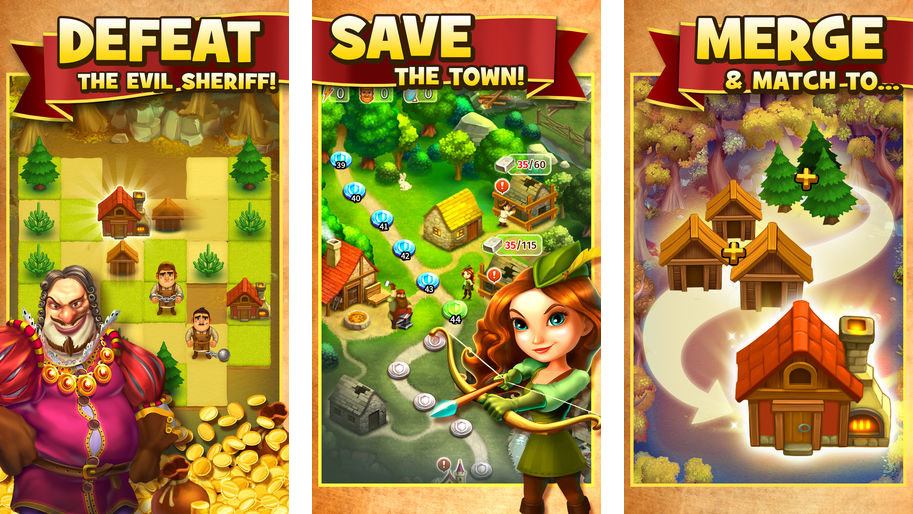
Robin Hood Legends
Six questions of deconstruction
Deconstruction asks six questions. If all of them are adequately answered, it should give us a pretty good idea about the kind of game we are dealing with. The questions are as follows:
- Who is the game’s audience?
- What is the game about?
- What is the game’s core gameplay?
- What are the game’s meta mechanics?
- How is the game monetized?
- What are the game’s problems?
1. Who is the game’s audience?
Big Fish Games boasts a rich history in publishing casual games on mobile devices. The company caters to the female audience in the 35+ age group. The concept and the art of Robin Hood Legends suggest that Sergey Neskin’s team worked on the game with precisely this demographic in mind.
а) The protagonist is a woman.
b) Fairytalish setting with no violence.
c) Calm and warm color palette.

The game is also suitable for a wider audience. There are no elements that would be negatively perceived by any social group. By and large, it’s stylistically neutral.
However, with the palette dominated by soft yellow and brown tones, the games often calls to mind mid-core titles by CIS developers. Casual games designed specifically for the western audience typically feature colors that are brighter, more vibrant.
Developer commentary
During our conversation, Sergey Neskin, CEO at Neskinsoft, pointed out that this aspect was overlooked at the preproduction stage: “It was much later into the development process that we realized the saturation was different than in other titles available in stores, but at this point, too much content was already made, so we only polished a few things and went ahead with what we had.”
2. What is the game about?
It’s generally accepted that the story plays a secondary role in casual games. Theoretically though, it can have an indirect impact on retention and stickiness.
And Robin Hood Legends does tell a story. It’s just much less articulated than in Playrix games.
The story puts the player in the shoes of Robin Hood during her (!) quest to restore order in the lands pillaged by the Sheriff of Nottingham and the Black Knight. There are peasants to set free, bear cubs to gather, roses to collect that are needed to restore the castle.
Developer commentary
According to Sergey, the narrative designer from Big Fish helped his team with the story: “We worked with Bay Anapol, the narrative designer, and together we redefined our storytelling approach, we set the epic goal that drove the development of the subsequent chapters in the game.”
Cutscenes are only used sparingly. The most the developers could afford is small squabbles between the protagonist and her adversaries. These are typically very short funny dialogues.
But all too often, even they are absent. The developers had to make do with one or two phrases in a bubble above a character.
Developer commentary
“You are right, we avoided loading too much history and text onto the player, but it was important to us to ground them in the setting so that they understand who they are in this world and what they have to do,” Sergey says.
This approach is intermediate between storytelling techniques used in Gardenscapes and Candy Crush Saga. The main task of the narrative is to provide the formal background to new quests and obstacles.
While this does little to facilitate retention (no intrigue means it isn’t exactly breathtaking), it can effectively build up the atmosphere of the in-game world.
The game also relies heavily on its protagonist, the female Robin Hood. A charismatic main character helps establish the brand. Reimagining Robin Hood as a woman is an interesting concept, but the result falls short of becoming a fleshed out character who would charm the players into revisiting the game over and over.
Developer commentary
On this one, Sergey begs to differ. He is confident that the team created a memorable trickster character that can easily fool her opponents without having to fight them.
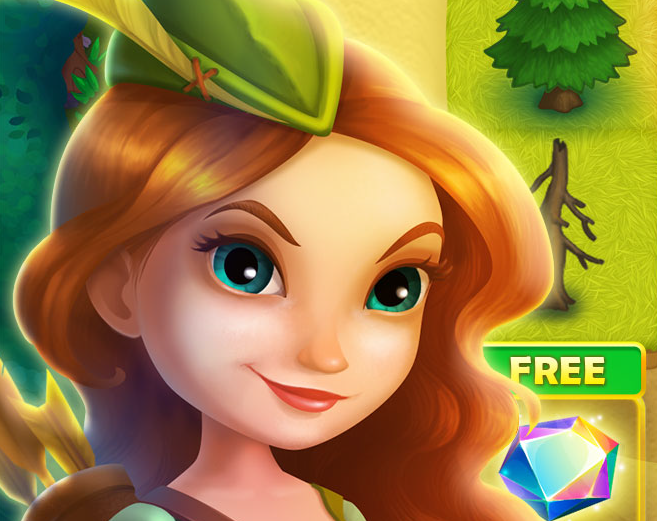
Game’s protagonist
3. What is the game’s core gameplay?
Neskinsoft is famous in the CIS market as the creator of multiple versions of Triple Town (Spry Fox, 2010). Robin Hood Legends is not an exception. It is the seventh project from the Belarusian studio that builds upon this mechanic, which Neskin refers to as “merge-3.” But this time, the developers have dramatically departed from the original.
First things first: here’s a quick recap on the Triple Town gameplay.
Triple Town Gameplay
The board is a 6×6 grid. Some squares are empty, others are occupied by various objects.
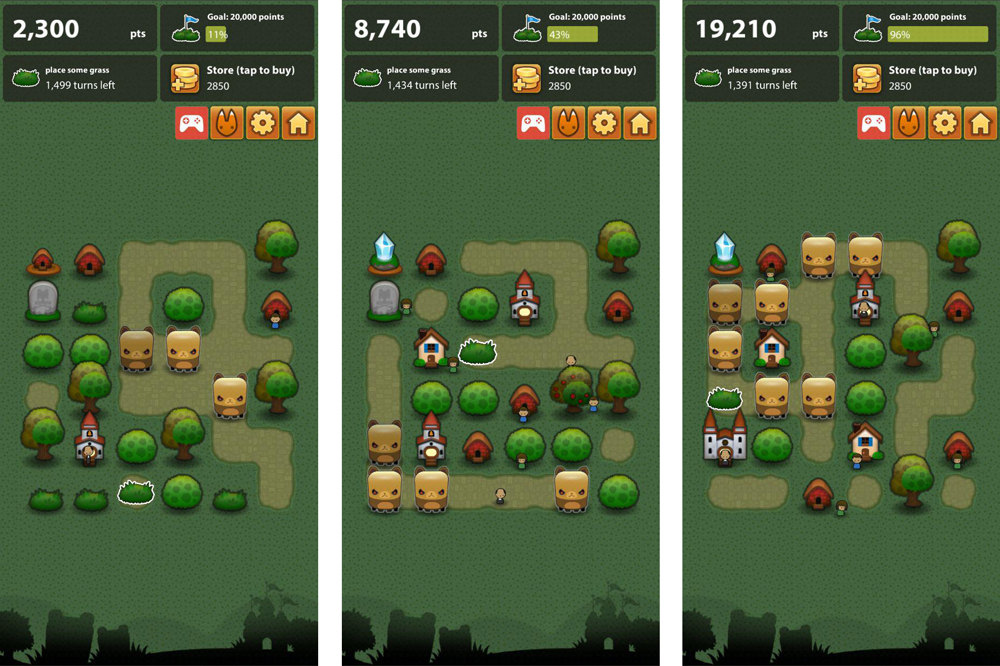
Triple Town
You can’t remove objects from the board. Instead, the player can fill the squares with the objects that they happen to have in hand. There cannot be more than two objects in hand at a time (i.e., once the player has placed an object, another one is generated in hand right away).
Three or more identical objects placed next to each other merge into a new object. A new object is created where the player has placed the last item required to form a combination.
For example, three adjoining bushes placed in a row disappear. Two squares become vacant. In the square in which the last bush was placed, a tree appears.

Example of how objects match in Triple Town
Newly formed objects can also match. Three trees create a house. Three houses create a better house, and so on.
In addition to objects, the player also fills the board with bonuses and bears that will obstacle the game.
The goal of Triple Town is to get the maximum score off the matches. The game is over when there are no more empty squares.
New tricks in Robin Hood Legends
Robin Hood Legends introduces two key changes to the original Triple Town gameplay.
The first one is a mission-by-mission structure similar to that of Candy Crush Sagа, that allowed the developers to implement several new conditions and obstacles.
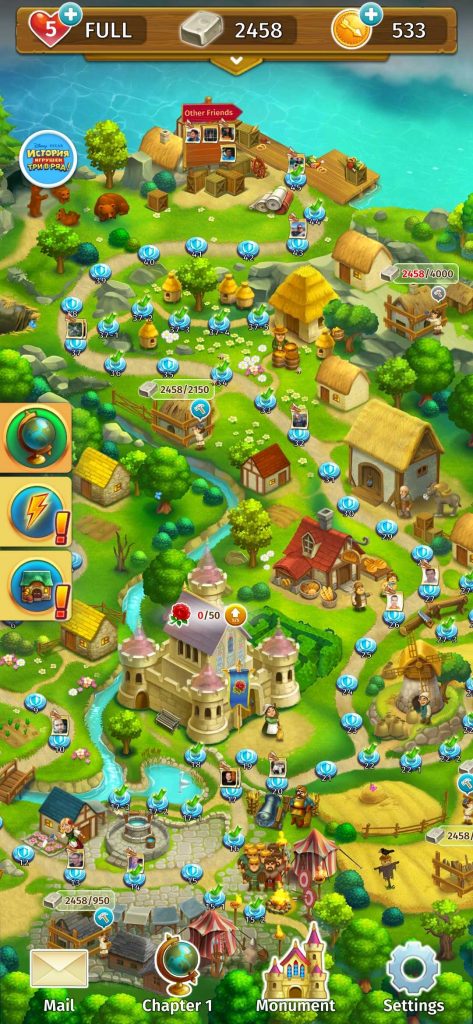
The map in Robin Hood Legends
The second and the most important one is that the player can now choose where a new object will appear — the options are limited to all squares adjacent to the one in which the last object was placed. The latter has made the game more tactical. Now it is possible to chain matches.
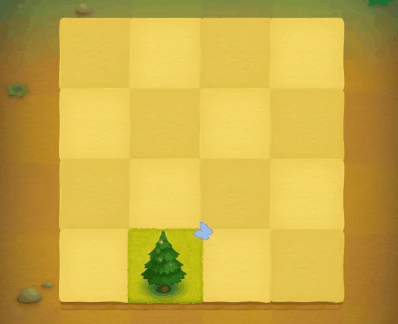
After a match in Robin Hood Legends, the player chooses a square where a new object will appear
For example, the player can configure a situation in which one match will result in a sequence of three.
Developer commentary
Being able to choose a place for a new-level object formed after a match, in Sergey’s words, was a game-changer that casualized the gameplay: “The original Triple Town wasn’t forgiving of the player’s mistakes, which made it less accessible to a casual player. In our Demokratia game, for example, this limitation was one of the key monetization techniques — at any time, the lawyer was ready to help the player move an inaccessible piece to any place for a nominal sum of about one dollar. But in Robin Hood, we wanted a more casual gameplay, so we decided to try and allow the player to move a piece by one square after a match. The playtests showed that this worked really well.”
It took some time for Neskin to come up with this decision. Initially, he was considering another way of making the game easier for the wide audience.
“We experimented a lot. At one point, we even tried a hexagonal board, which would make matching easier as there would be more neighboring pieces. But ultimately, we decided that it was better to allow players to move a piece after a match, so the exotic hex board concept was scrapped along with other casualization options,” says Neskin.
Pros and cons of the core mechanic
The main problem with the gameplay is that it’s entry threshold level is higher compared to the conventional casual mechanis like Match-3 or Solitaire. You can’t just tap your way through the game.
To progress in a game, at each step the player must:
а) evaluate the situation on the board;
b) look at the both objects in hand (to do this, you have to move the object from hand to a special cell);
c) estimate where on the board matches can be chained;
d) tap to move an object onto a square;
e) if a chain match is possible, choose a new square.
It’s much more interesting than the classic match-3, but when you learn how to use it, it takes more effort than other mechanics in the niche.
Developer commentary
Neskin made it clear that the studio was well aware of that: “We knew from day one that this mechanic would take some getting used to. So from the very beginning, we worked very hard on the tutorials, on that first-minute in-game experience.”
Sergey says that players don’t leave the game because of the mechanic, not anymore: “ Our team did a good job fine-tuning UX to engage the target audience, so we are happy with the player retention levels upon the completion of the tutorials.”
It wasn’t all smooth during earlier development stages. For example, it was only after a while that the developers realized that if a booster is introduced in one level, it needs to show up again in the next one to reinforce the learning process.
The developers also struggled to stop players from swiping objects to the board. Additional features had to be added. Now, if a player tries to move an object, an arrow appears pointing to a special window from which an object should be taken.

Arrow pointer in Robin Hood Legends
The developers also did a fairly good job on the controlled randomness. Subjectively, it feels like your skills only account for roughly 50% of your success, the rest is up to the object generation program that does not drop objects completely randomly.
Controlled randomness is an important game design element and a convenient tool for difficulty management. Depending on how well it’s balanced, it will differently affect the level dynamics, the player’s emotions and, ultimately, whether they are prepared to pay in case of failure.
And this latter aspect of the game is certainly problematic. While beating levels is fun, Robin Hood Legends doesn’t give you a lot of reasons to use a booster or buy additional moves.
4. What are the game’s meta mechanics?
For the purposes of this article, the term “meta” refers to a set of secondary gameplay mechanics designed to structure each session and the player’s progress, as well as to improve retention and engagement.
Sessional gameplay
The way sessions are structured is typical for casual games. There is a map and there are levels. Completing a level unlocks the next one. This constitutes the progress in the game.
The map
There is no single map that would encompass all levels. The game is divided into chapters.

New chapters gets unlocked as the player progresses in the game
Each chapter has its own map with several dozens of levels. The first one, for example, has over 50.
Chapter division is likely to be dictated by purely technical reasons. There is no real sense in having several maps. On the contrary, there is only one amount of resources (more on that in the part on the game’s economy) for all maps, so why not have a single map like in classical titles by King?
Maps in casual games are not trendy anymore. The lack of replay value (to be discussed later) and the arrival of building and narrative mechanics made them meaningless.
However, it is a popular idea that maps help integrate the social and competitive elements into gaming, which theoretically increases engagement over repeated playthroughs. For exapmle, maps can display your friends’ progress. Many studios use push notification to inform players on who among their friends has got ahead of them on the map or outscored them in a particular level.
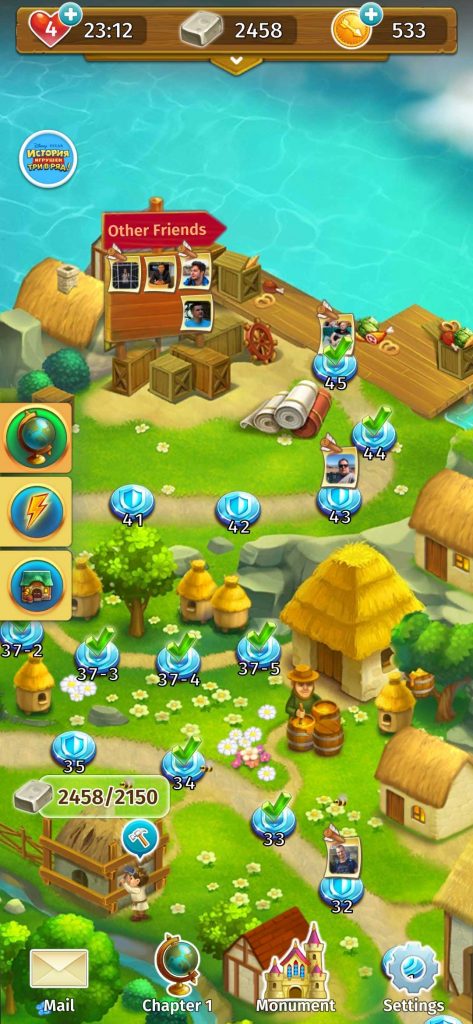
You can learn friends’ progress from the map
Every now and then, there are forks in the road. The player can choose which path they would like to take. This freedom is fictitious. To progress further, you need to play through both paths.
Forks in the road is an interesting concept. But it’s a cool feature for its own sake. Casual players who routinely play for fun in the space of two minutes do not really need this kind of freedom of choice.
This freedom only makes sense if both levels that follow are very difficult. Then the player will have more variety within a session. They will not replay the same level dozens of times. Instead they will be able to alternate them. Theoretically, it should encourage them to continue playing the game.
Quests, difficulty levels and repeated playthroughs
Beating levels alone is not enough to progress in a game (i.e. to unlock new levels). There are progress blockers in the game: quests.
Most quests in Robin Hood Legends boil down to repeated playthroughs of several levels.
Forced replay is a traditional way to slow down the progress, which is generally avoided nowadays. It annoys players. And one thing developers do not want players to feel is annoyed.
A typical example from Robin Hood Legends: in Chapter Two, the player completes levels 23, 24 and 25. After that, the player is told that they need to build a catapult. To that end, they need to gather parts. And the parts can be found in the very same levels that the player has just completed.
The knee-jerk reaction to this is to immediately quit the game.
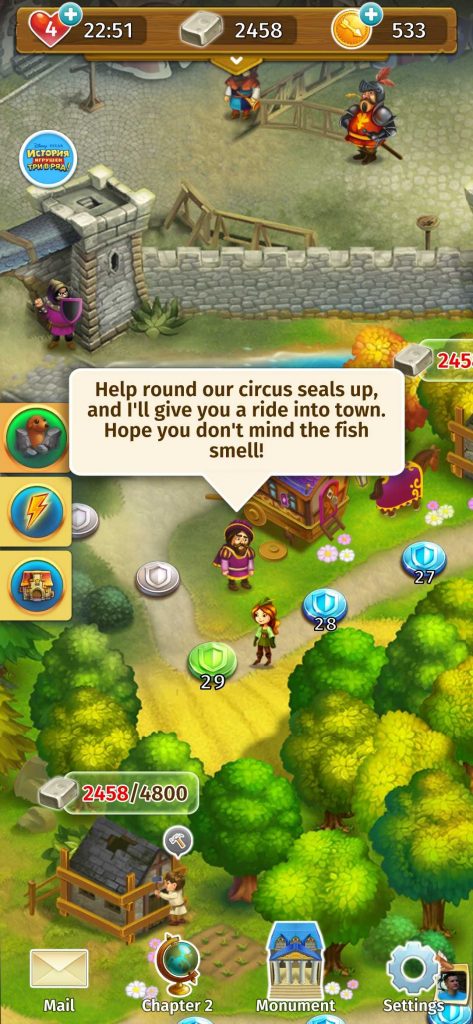
That’s how quests are handed out in the game
From the standpoint of analytics, it’s not the best move either. You have too many conditions per level. And if they are not laid down, quests will cause players to leave the level.
On the whole, repeated playthroughs do not make a lot of sense in casual games. Levels are cheap enough and quick enough to produce as it is.
A much better idea to take a level, slightly modify it and present it to the player like it’s new content 40-50 levels later.
But in this particular Neskinsoft title, quests are not the only thing that motivates users to replay levels. Each level can be played on three difficulties. Awards (game currency) are only given for the first playthrough on each difficulty.
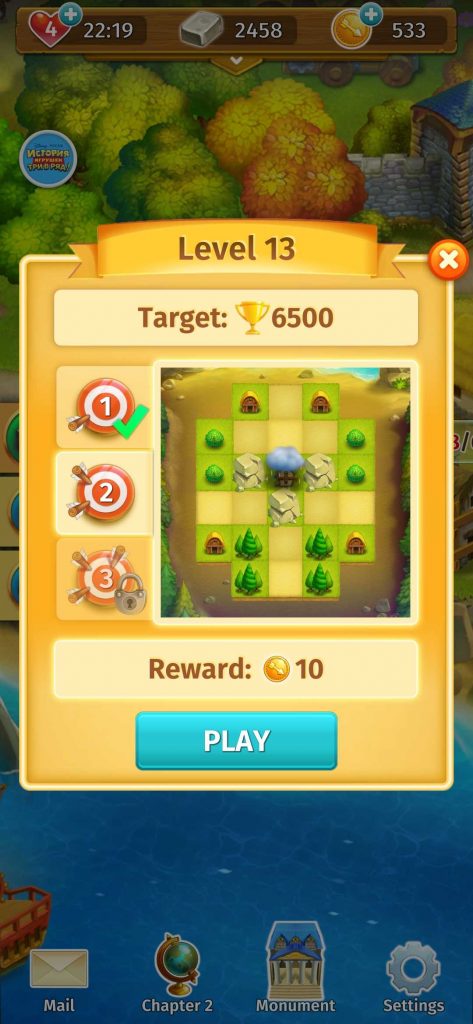
Each level has three difficulties
Formally, it’s a step towards the non-paying audience. Thanks to this mechanic, players get more game resources. However, as was mentioned before, this might complicate the game’s analytics.
Besides, it would be more player-friendly if beating each difficulty unlocked a rewarded video. Replaying the levels previously completed, even for additional resources, is by far not the most pleasant way to spend time.
Developer commentary
The situation with the forced replay, Sergey explains, has to do with the fact that when borrowing the meta mechanics, the studio lost sight of what constituted the core gameplay.
“Usually, we take our cue from the figures. We implement a mechanic, look at the results, and then make the decision whether to keep it or not. Unfortunately, experimenting with meta gameplay sometimes takes a lot of effort, so we decided to borrow some meta elements from other titles that perhaps are not as relevant today as they used to be (e.g., Gummy Drop).
Completing a usual level in a classic match-3 game requires less effort from the player than the merge-3 mechanics. Subjectively speaking, in Candy Crush, the luck/skill ratio is roughly 50/50, while in merge-3, in spite of everything we did to make the gameplay more causal, there is a strong strategic element, and the luck/skill ratio feels more like 30/70, which does not reflect well on the players’ motivation to replay the levels.”
Economy
Formally, there are two kinds of recourses in the game, but in fact, there is just one — gold.
Gold is a hard currency which is spent on bonuses (e.g., the mirror can create a copy of any object on the map), moves (if you have used up all the moves, you can buy five more), and hearts (additional purchase of hearts, which restore over time).
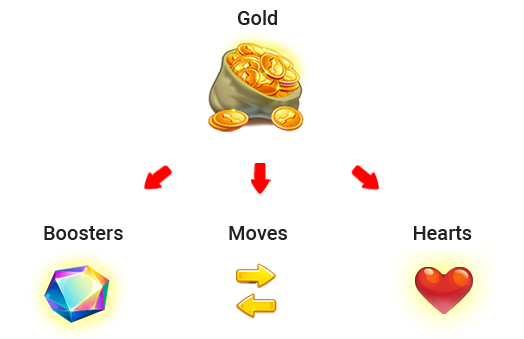
All other resources are a source of additional gold, which is why it’s more logical to count them as various ways to obtain the hard currency, rather than set them apart as a separate entity.
Ways to obtain gold:
а) Stone
Stone is spent on the repair of buildings scattered across maps. Any repair yields a little gold at a time.
Stone is also awarded on the completion of levels.
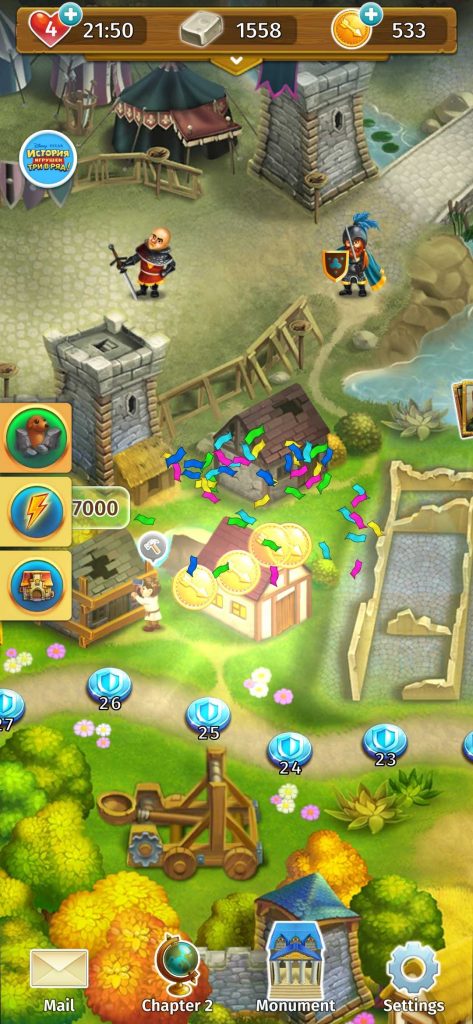
Confetti and gold for the building repair
b) Monuments
Big structures are scattered across maps. They are built in several stages, and building them requires objects which can be found in various levels.
Erecting monuments also yields gold.
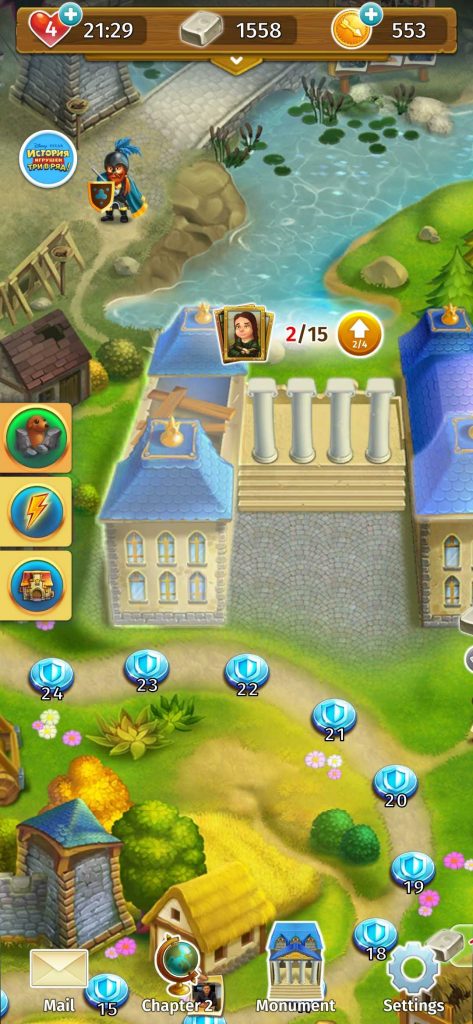
Each location necessarily has a monument that is erected in several stages for unique currency. For example, to build a castle you need to collect Mona Lisa paintings
c) Real money
The game has a store with seven items ranging in price.
- Booty$0.99
- Prize$9.99
- Loot$4.99
- Starter Pack$4.99
- Haul$19.99
- Pillage$39.99
- Spoils$99.99
d) Completing levels
As was mentioned earlier, each level has three difficulties. After the first completion, the second difficulty is unlocked, which, once completed, will give access to the third one. At the first playthrough, each difficulty yields a certain amount of gold. The higher the difficulty, the higher the reward.
е) Quests
There are two types of quests in the game: timed and permanent ones. The only difference is that the timed quests have a timer. Both types reward the player with gold when completed.
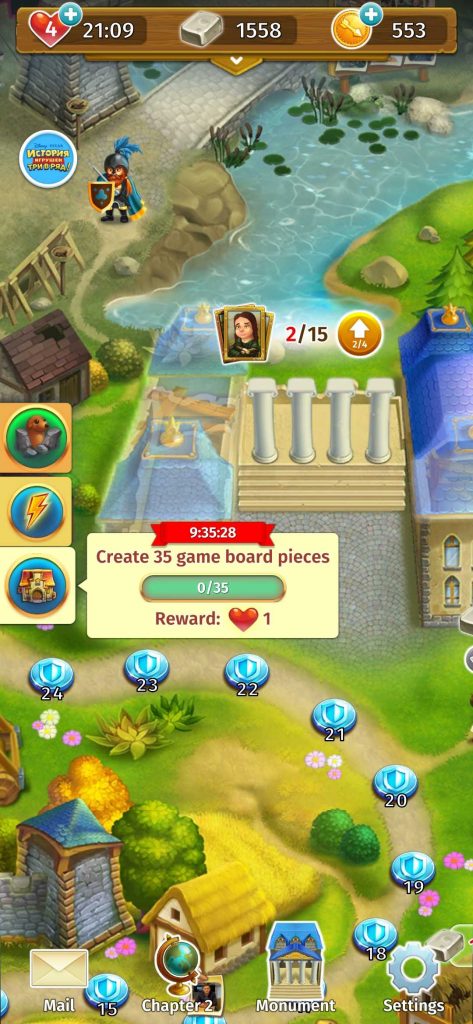
Timed quest
f) Chests
During the game, chests (a type of an obstacle which appears and disappears after the player matches several objects) can drop several coins.
Making additional resources function as consumables that can be exchanged for the main currency is an interesting decision which allowed to diversify the gameplay without overcomplicating the meta. Moreover, this element is optional to the point it can easily be ignored.
The game’s economy is designed so as to allow the non-paying audience to earn gold to complete difficult levels, but at the same time experience the significant shortage of this resource.
In other words, producing gold is time-consuming and the prices for the supplies are high.
For example, the first completion of the level yields 5 gold coins and 500 stones. For the restoration of a building that is worth 1200 stones, you get 10 gold coins. Quests that take several hours to complete will give you 10 gold coins or more. And one bonus will cost you 200 gold coins.
So to get a bonus allowing to complete a difficult level (or purchase hearts), the player will have to complete 40 levels. Or roughly half as many, if they also do a lot of building.
Developer commentary
“We considered plenty of variants, at one point we even tried to implement a money-box where all the coins are stored that you earned in different levels. In the end of the day, we kept the most efficient and, as it happens, the easiest option. We are not going to shock our current players, further experimentation will only take place in our future projects.”
5. How is the game monetized?
As was noted before, the games offers 7 IAP items costing various amounts of gold. These are the only items you can buy directly from within the game. And as for the shortage of the main resource, this concept is completely transparent and standard for projects like this.
In terms of in-game advertisement, the game features cross promotion.
6. The game’s problems
In addition to insufficiently bright graphics, forced replay, and the high entry threshold, the game has one other critical problem. Modern three-in-a-row games try their best to stop the player from getting bored. This is achieved due to new elements being introduced into the gameplay as often as possible (chocolate, ice, fizzy drinks, and so on).
Robin Hood Legends does it regrettably seldom. No wonder you get the impression that levels lack distinct feel and all resemble each other.
Developer commentary
Neskin debates the notion that the game lacks in mechanics variety.
“If I’m not mistaken, for 7 locations, we have around 25 gameplay mechanics. On average, that’s two new mechanics introduced per location. The only exception is the first location where the player is exposed to more. And then we combine them in all sorts of ways, so that the player does not get tired from all the new elements.”
Another disputable aspect has to do with the fact that in each map (chapter/location), objects do not look the same. For example, in the first map, trees and bushes look one way, and in the second map, they look different. Yes, it creates variety, but you know what else? Stress.

First line — objects from Chapter One, second line — from Chapter Two
The player has only just got used to the objects in the map and is looking forward new mechanics, when suddenly they have to get to learn what the objects look like again. The rules, however, do not change. Bushes still create trees, trees still create houses, houses create manors, and so on.
Not only does this decision potentially cause players to quit between chapters, it also increased production costs.
Developer commentary
“It really was just something that we did to keep it looking fresh and visually diverse. It’s not your classic match-3 type of gameplay where you make objects disappear by matching them, with merge-3, a new object appears as a result of a match, and that’s essential for the perception.
One other flaw I can think of is that our actions on the game board are a little bit out of sync with the epic goal that we adopted earlier. In the map, we conquer the tyranny, but what is happening on the board is players building houses. At some point, our guys decided to go ahead with other concepts that suited the meta mechanics better, but all of them just complicated decision-making in evolutionary chains, which is why we decided to make our peace with the all building. At least it was simpler and more familiar for the player.”
7. Key takeaways
According to DataMagic, following the release, the game used to bring in over $60K per month. Now, one year later, its monthly revenue is around $15K
The project turned out interesting enough. But it still raises many questions, some of which are shared by the team.
When asked if he was happy with the title, Sergey responded that he would like to have achieved better replayability and cut costs associated with new content production through smarter game development decisions.
